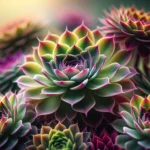Introduction to Red Beauty Sempervivum
Imagine a carpet of crimson, each rosette intricately painted with hues of red that deepen with the kiss of sunlight. This is the essence of the enchanting Red Beauty Sempervivum, a succulent that weaves a rich tapestry of color and texture in any garden space it graces. Often found nestled in rock gardens or perching delightfully in container displays, this hardy charmer brings an artistic flair to the world of gardening.
With its easy-going nature, the Red Beauty Sempervivum has been the plant of choice for gardeners seeking to inject a vibrant splash into their green haven without the fuss of high maintenance. Picture your garden in the midst of winter, the air crisp and the leaves elsewhere have fallen, then picture the Red Beauty standing resilient, its bold color undiminished by the chill. It is a plant that endures, that offers year-round interest with its ever-changing palette.
The versatility of the Red Beauty Sempervivum extends beyond its visual appeal; it is a testament to the concept that beauty need not be fleeting nor require arduous care. A real-life example can be found in the tranquil rockeries of enthusiasts from the highland terrains to the coastal plains who cherish this succulent’s ability to adapt and thrive. It practically cares for itself!
For anyone looking to delve deeper into the realm of succulents, explore our treasure trove of care tips and strategies for cultivating these charming species, forming your very own lush and enduring garden scape. Take a step into the world of the Red Beauty Sempervivum and let your garden narrative unfold into one of vibrant resilience and effortless charm.
Botanical Profile of the Charming Red Beauty
Step into the vibrant tapestry of your garden, and it’s likely the Red Beauty Sempervivum will catch your eye. Not merely another green thumb’s delight, this sempervivum species spins a tale of resilience and allure with its distinctive rosettes that burst in colors reminiscent of a fiery twilight. So, what makes the Red Beauty stand apart in the gardener’s palette of plants?
Forged from the harsh mountainous terrains of Europe, the Red Beauty brings an otherworldly resilience to our gardens. It’s not just a plant; it’s a survivor, defiant against drought and unfazed by frost. Its fleshy leaves, tipped with an ever-changing spectrum of reds, wrap tightly into a roundel that seems painted by nature’s own delicate brush.
In the peak of summer, when blooms decide it’s their time to shine, the Red Beauty erupts into star-shaped flowers, standing tall on fleshy stems. This moment, fleeting as it may be, adds a dash of drama to its Mediterranean narrative. Each rosette, a self-sustaining entity, sprawls out to form a dense yet orderly cluster, making it perfect for a groundcover that’s both aesthetically pleasing and practically carefree.
Gracing the landscape with its easy-going demeanor, the Red Beauty doesn’t demand the limelight but effortlessly steals it. Its growth habit allows it to thrive unfettered, spilling over rockeries or snuggling up against garden pathways. In the world of sempervivums, it’s truly a gem that punctuates the green with its robust charm.
Discovering its allure isn’t just about appreciating its hardy nature; it’s about understanding how this plant can set the stage for a garden that defies conventional beauty. As you mull over tips for the perfect plant growth, imagine the Red Beauty as your trusted companion, bringing a touch of Europe’s rugged mountains to your doorstep.
And now, let’s feast our eyes on an example of this succulent charmer:
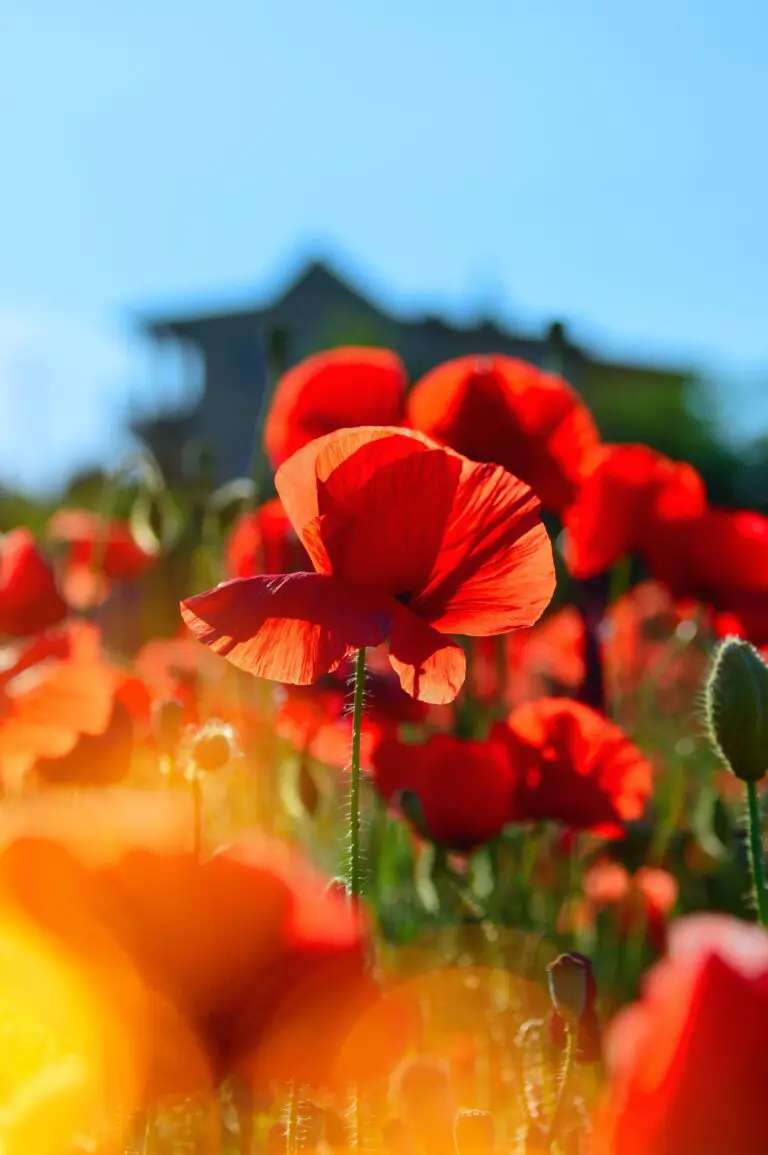
This botanical marvel doesn’t merely exist; it thrives with a silent yet emphatic presence that’s as captivating as it is enduring. The Red Beauty Sempervivum is more than just a plant; it’s a statement of nature’s indomitable spirit and an ode to the gardeners who revel in the elegant tapestry of life.
Optimal Growing Conditions for Lush Succulents
If you’ve ever marveled at the hardy charm of Red Beauty Sempervivum, you’ll understand why these robust rosettes steal the show in gardens and home terraces alike. But what makes these succulents flourish with minimal fuss? It’s all about emulating their ideal environment! Let’s get our hands in the dirt and explore how to provide the perfect home for these vibrant beauties.
First up, sunlight! These plant pals are sun worshippers that bask in the glory of bright light. Imagine a mountainous region—rocky and open—where sempervivums spread their colorful, textured tapestries unhindered. In your garden, aim for a spot where sunshine reigns supreme, as direct sunlight energizes them for at least 6 hours a day. But, just like us, too much of a good thing can lead to sunburn, so a smidgen of afternoon shade won’t go amiss, especially in scorching climates.
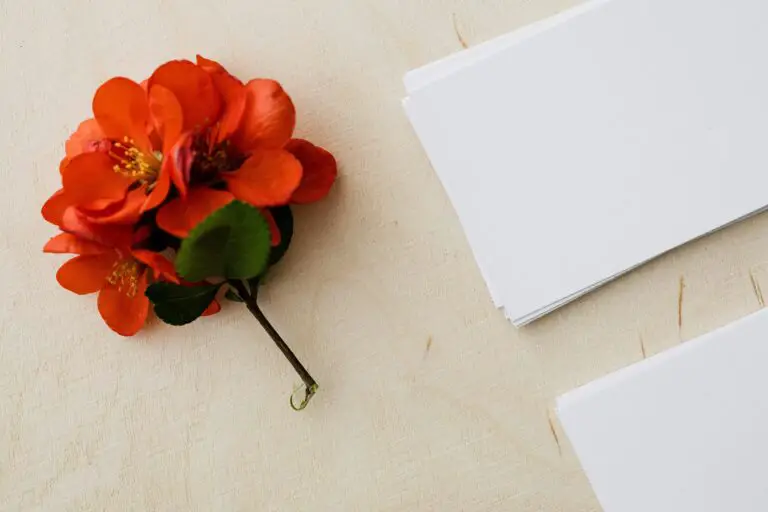
Dreaming of a lush succulent that demands barely a glance? You’ve got it! Red Beauty’s roots revel in gritty, well-draining soil that says “no thank you” to water-logging woes. Mix in some sand or perlite with your potting medium to mimic their native, stony terrains. Water them sparingly—think of it as a rare treat rather than a daily routine. Allow the soil to dry between waterings to keep those fleshy leaves firm and fabulous.
Interweaving with vibrant companions, these succulents are not just solo stars. They play nicely in succulent ensembles where each plant’s unique hue and texture bring out the best in their neighbors, creating a living mosaic that’s ever-changing with the seasons. Picture them nestling among pebbles and moss, spilling over rock walls, or standing proudly in a terracotta pot by a sunny window.
Beyond their carefree nature, their tenacity is legendary; sempervivums laugh in the face of frost, bravely soldiering through winters that would make other succulents shiver. But don’t let their toughness fool you—underneath that robust exterior lies a soft spot for drainage. Ensure containers have drainage holes and that garden beds are raised or slope gently, avoiding any potential for soggy feet, which are a sempervivum’s kryptonite.
Step by step, tailoring these conditions will not only keep your Red Beauty Sempervivum in peak form but also transform your green space into a succulent sanctuary of serenity and strength. It’s a simple recipe for success: bright light, lean soil, sparse water, and good company. With this low-maintenance approach, you’re not just growing plants, you’re cultivating resilience and beauty that endure season after season.
Planting and Maintenance Best Practices
Embarking on the adventure of growing Red Beauty Sempervivum is like composing a living tapestry in your garden. The vibrant red hues, hardy resilience, and aesthetically pleasing symmetry make it a sought-after succulent for any plant lover.
Setting the Stage: Planting Your Red Beauty
To ensure the best start for your Red Beauty Sempervivum, choose a location that speaks to its needs: ample sunlight, good drainage, and space to spread. Planting in the spring allows the root system to establish itself during the growing season. Think of it as setting the stage for a performance—the better the foundation, the more remarkable the show of color and form.
Anecdotes from seasoned gardeners often highlight the charm of these beauties in rock gardens, where each plant emerges like a ruby among stones. Or nestling them in a wall crevice, allowing their roots to delve deep into nooks, portraying a picture-perfect scene of nature’s tenacity.
Nourishing Your Garden’s Red Jewels
Water sparingly, as the Red Beauty Sempervivum is a drought-tolerant succulent. Overwatering can lead to root rot, which is the nemesis of this otherwise hardy specimen. The rule of thumb is to let the soil dry between watering, mimicking their native alpine habitats where rainfall is a boon, not a given.
Fertilizing should be a minimalist affair. A light feeding in early spring can encourage growth, but too much and you may find your Red Beauty’s color subdued, its hardiness compromised. Imagine feeding a delicate bonsai—it’s the precision that counts, not the quantity.
By adhering to these practices, your Red Beauty Sempervivum will not only survive but thrive, weaving a tapestry of robust charm that’s as carefree as it is captivating.
Designing with Red Beauty: Aesthetic Appeal
Imagine a garden where each plant plays a vital role, a tapestry woven with the threads of nature’s most resilient species. The Red Beauty Sempervivum stands out, not only for its vibrant hue but also for its rugged beauty. From rock gardens to roof plantings, this hardy succulent lends a touch of robust elegance that demands attention.
When it comes to designing with the Red Beauty Sempervivum, it’s all about contrasts and complements. Picture it nestled against a backdrop of silver-blue ornamental grasses or creating a stunning contrast with golden sedums. The palette of possibilities is as broad as your imagination, and the Red Beauty always holds its own.
But it’s not just about looks. This plant is a testament to the resilience of nature — it thrives where others falter, in arid conditions where the dainty flowers of spring have long disappeared. In a world of green, its red rosettes are like a siren’s call to the eyes, providing a focal point that anchors the garden’s aesthetic.
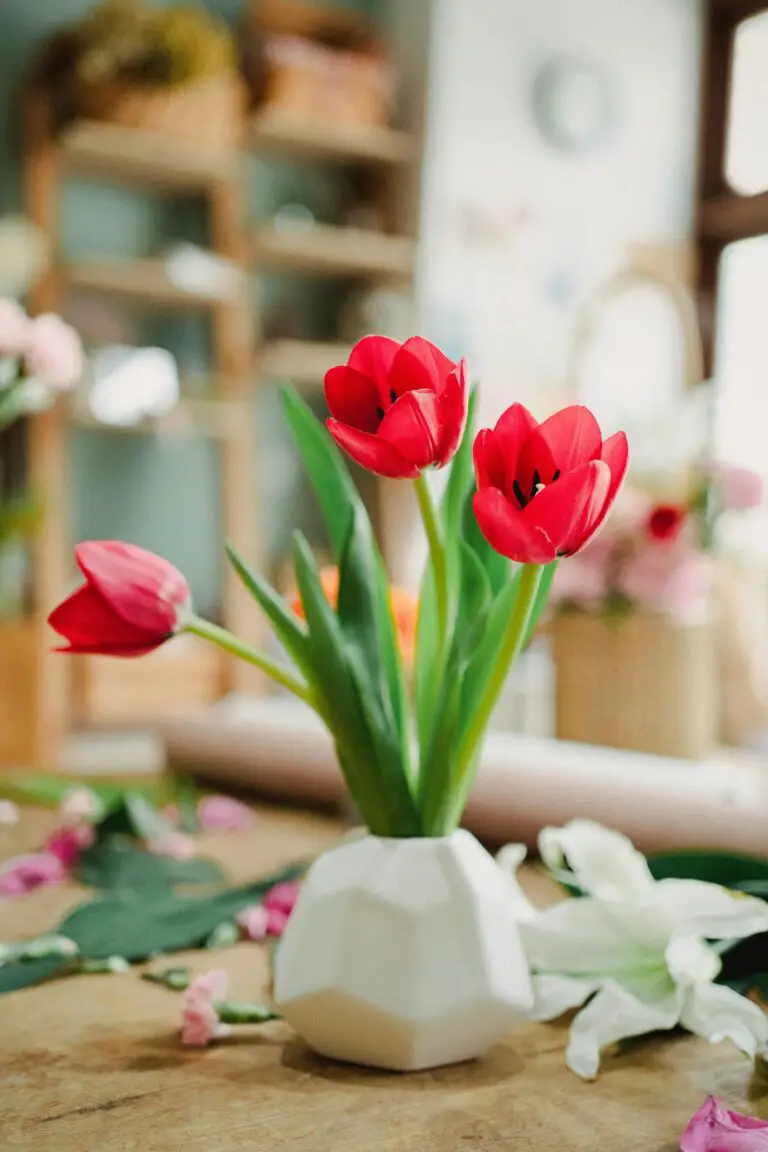
For the urban dweller with limbed balconies, or the suburbanite with wide stretches of lawn, the addition of Red Beauty Sempervivum transforms space into a landscape of visual intrigue. Its symmetrical growth pattern and rich coloration pair beautifully with the geometric shapes of hardscaping, be it the smooth curves of a stone path or the rigid lines of a timber deck.
Real-life gardens across the world have embraced the Red Beauty.Succulent enthusiasts in Portland have framed their garden paths with its bold presence, while rooftop gardeners in Brooklyn utilize its drought-resistant nature to create oases in the sky. Each use case employs the sempervivum’s unique characteristics to enhance the beauty of their green spaces.
Let’s not overlook seasonal shifts—where most plants whither, Red Beauty Sempervivum embraces the cold, often intensifying in color and proving once again that with the right elements, a garden can be a year-round exhibition of nature’s most exquisite artistry. The lesson here is simple: this plant isn’t just a pretty face—it’s a symbol of adaptability and endurance, principles that any gardener, novice or expert, can appreciate and incorporate.
Propagation Techniques for Expanding Your Collection
You’re about to become a ‘propagation wizard’ with “Red Beauty Sempervivum,” a succulent that not only adds pops of robust red to your garden but also carries the magic of easy multiplication. Let’s roll up our sleeves and dive into the world of multiplying these hardy charmers!
Starting with Offsets: The Simplest Path to More “Red Beauties”
Every “Red Beauty Sempervivum” is a gift that keeps on giving, sprouting mini versions of itself known as offsets. Picture this: You notice a little plantlet snuggled up to its mother plant, hinting it’s ready to brave the world solo. Snip it free with a sterile blade, nestle it into well-draining soil, and behold the sprouting of new life. It’s like the mother plant is whispering, “Go forth and flourish, little one!” And flourish they will, with a pinch of care and a lot of love.
Seeding: Witnessing the Birth of New Generations
Have you ever marveled at nature’s patience? Seeding sempervivums is a bit like that—sowing patience and reaping a tapestry of textures and colors. With “Red Beauty” seeds, you’re the guardian of potential, tucking them into a sandy soil mix and maintaining a fine balance of moisture—not too much, not too little. You’re on your way to curating a haven of red-hued marvels, each seed holding the promise of a unique rosette.
The joy of propagation doesn’t stop at expanding your own garden—it opens a channel to share with fellow enthusiasts. Imagine swapping different sempervivum beauties with friends, a true gardeners’ exchange of botanical treasures. So, whether you’re a beginner or a seasoned green thumb, the art of multiplication with “Red Beauty Sempervivum” is a journey worth embarking on, full of surprises and splendor at every turn.
Common Challenges in Growing Red Beauty Sempervivum
Just like a seasoned gardener kneels in the dirt, nurturing each plant with precision and care, the Red Beauty Sempervivum requires a watchful eye to prevent the insidious grasp of pests and diseases. In our gardens, we must stand as vigilant sentinels, understanding that even these robust succulents can fall prey to sly invaders and silent ailments.
Knowing Your Adversaries
The first step in our battle for the health of our Red Beauty Sempervivum is to identify the common foes. Aphids, those tiny sap-sucking villains, may launch an assault, cloaking the vibrant rosettes in a sticky residue. Similarly, spider mites, too small to see with a casual glance, can weave a fine web of destruction. And let’s not forget the root-eating nematodes, lurking below surface, ready to undermine the very foundation of our garden tapestries.
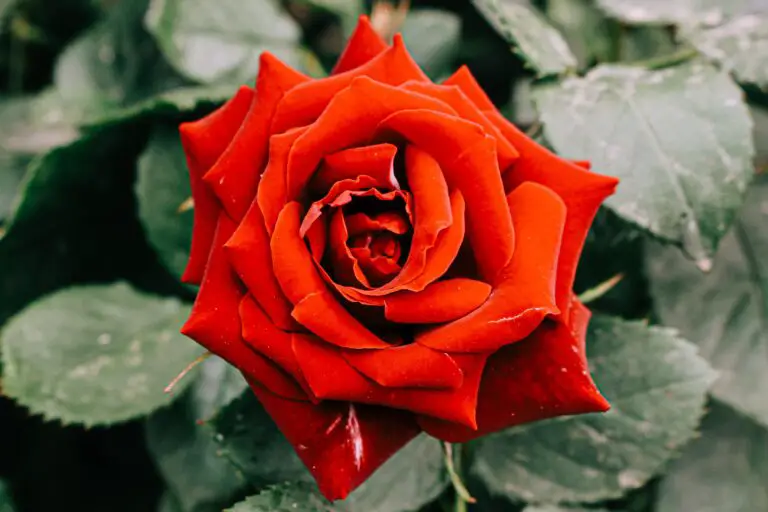
Fortifying Against Invasion
Fortification is key—keeping an ecosystem that encourages natural predators, such as ladybugs, can be a line of defense. But when these critters breach our borders, a prompt response is crucial. Insecticidal soaps or neem oil applications can serve as our arsenal, repelling the miniature marauders without resorting to the brutality of chemical warfare that could harm beneficial organisms and the environment.
Spotting the Signs of Sickness
While pests pose a palpable threat, diseases are the silent saboteurs. Overwatering our Red Beauty Sempervivum can set the stage for an outbreak of fungal infections such as root rot, where the signs may only become evident when it’s nearly too late. Vigilance in watering practices and ensuring proper drainage can prevent this calamity.
Real-life anecdotes from fellow gardeners speak volumes about the necessity of monitoring for blight and mildew. Sempervivum aficionado, Jane, recounts how quick action and trimming away infected parts saved her collection from a dire fate. These experiences underline the importance of proactive observation and intervention.
Arming with Knowledge and Care
The art of growing Red Beauty Sempervivum is a blend of constant care and informed decisions. Arm yourself with knowledge, understand the threats, and you’ll weave a tapestry of rugged beauty that stands resilient against the trials posed by nature’s unseen forces. Indeed, the battle may be ongoing, but the rewards are unmistakably profound—a flourish of hardy charm that hails victory in our cherished gardens.
Conservation and Sustainability of Sempervivums
Amidst the green tapestry that graces our gardens, Red Beauty Sempervivum stands out not only for its vivid hues but also for the eco-friendly ethos it can embody. As the canvas of horticulture shifts with the climate and our newfound respect for the land, sustainable gardening practices have taken root, significantly impacting how we cultivate plants like the robust sempervivum.
At the heart of sustainable gardening lies the conservation of resources and the support of local ecosystems. Sempervivums, with their low water needs and resilience to pests, champion this approach. For instance, by interspersing these hardy succulents amidst other flora, a diverse microhabitat buzzes to life, attracting essential pollinators like bees and butterflies. It’s a small act with a big payoff; swapping out water-guzzling ornamentals for sempervivums not only saves H2O but also bolsters local biodiversity.
Moreover, sempervivums contribute to an eco-friendly cycle. Thriving in rocky nooks and crevices, these hardy plants soften the harsh scape, creating pockets of life. They demonstrate the potential to reclaim and beautify spaces from degraded lands to rooftop gardens, all while asking for nothing more than a sliver of soil to call home.
Embracing Biodiversity with Every Cluster
Consider the story of a small-town gardener who transformed a once barren lawn into a sanctuary for wildlife using sempervivums as keystones. What began as a colorful accent evolved into a hub of life and activity, demonstrating how these succulents can serve as catalysts for environmental enrichment. The garden now flourishes, a testament to the principles of conservation and biodiversity at work.
Incorporating sempervivums is not just a gardening choice; it’s a nod to a global movement of sustainability. Every sempervivum planted is a step towards reducing carbon footprints, as they require minimal intervention and resources. Plus, they’re propagation pros—just a single leaf can give rise to a new rosette, embracing the cycle of life with minimal waste.
And when it comes to understanding and applying sustainability with sempervivums, let’s take a visual dive. Here’s an insightful video demonstrating sustainable gardening with these resilient wonders:
As we step back and admire the scarlet and green collage offered by the Red Beauty Sempervivum, we see more than just a plant. We observe a symbol of hope and harmony—a champion of sustainability—sewing the seeds of a better tomorrow, one resilient rosette at a time.
Frequently Asked Questions
Embarking on the journey of nurturing a Red Beauty Sempervivum brings with it a tapestry of wonder and a bouquet of queries. Enthusiasts and green thumbs, alike, often reach out with questions that buzz around the horticultural hive. Let’s dig into some of those burning questions with answers as vivid and robust as the Red Beauty itself!
What Makes the Red Beauty Sempervivum a Garden Standout?
Imagine a hardy plant that thrives where others shy away—this is the essence of the Red Beauty. Its resilience to neglect makes it a favorite among gardeners with busy bees schedules. A neighbor recently shared how despite a hectic week, her Red Beauties were as bright and plump as ever, unfazed by the hustle and dust of daily life!
How Often Should I Water My Sempervivum?
“Only water when the soil is dry!”—this is the mantra to follow. Overwatering is akin to overindulgence, and just like you, your Sempervivums prefer to keep things moderate. Consider the rainfall in your chorus of care and adjust your watering solo accordingly.
Does It Need a Special Type of Soil?
Well-draining soil is the throne on which your Red Beauty perch should be crowned. They aren’t fans of soggy feet, so a mix with ample sand or gravel will make them feel right at home. Think of the well-textured soils like the perfect bed—firm, yet comfortable enough for prosperous slumber.
Can I Plant Red Beauty Sempervivum in Containers?
Absolutely! In fact, containers offer a stage where this succulent can truly shine, showcasing its symphony of color and form. Just ensure that there is a drain in the pot, as proper drainage is non-negotiable for the well-being of these plants.
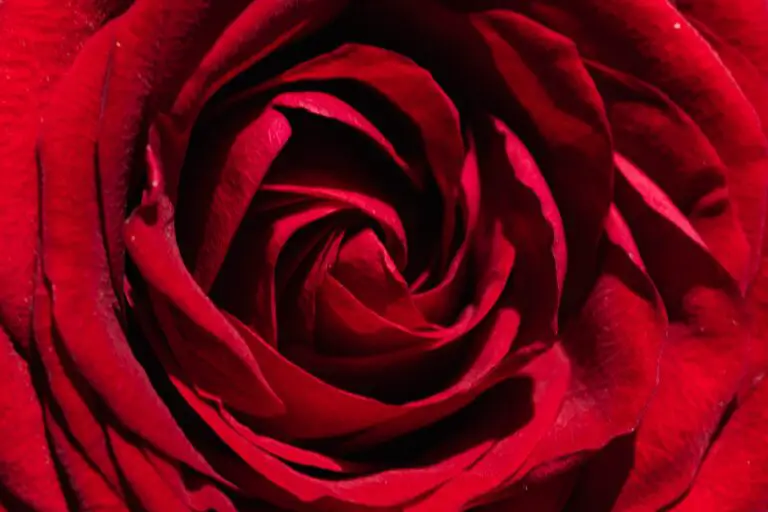
How Do I Propagate the Red Beauty?
Propagation is as simple as gently separating the “chicks” from the mother “hen” and giving them their own space to flourish. It’s a natural process that’s quite forgiving, even for those who are new to the propagation tango.
What Types of Pests Should I Look Out For?
Mighty in demeanor, but not invincible. Aphids and mealybugs might occasionally dance upon the leaves, so keep a vigilant eye and intervene with organic methods to keep them at bay. Remember, the key is to be proactive rather than reactive.
When Will I See Flowers?
Patience, young grasshopper, for beauty unfolds in its own time. Typically, flowering occurs in the summer, sending up a central stalk as if it were reaching for the sun’s warm embrace. The blooms are a delight, but also a swan song, as they signify the final act of the plant’s life cycle.
Consider each query a step towards mastering the art of Red Beauty Sempervivum care. With each answer, you weave another thread into the hardy charm of your garden’s tapestry. Happy gardening!

